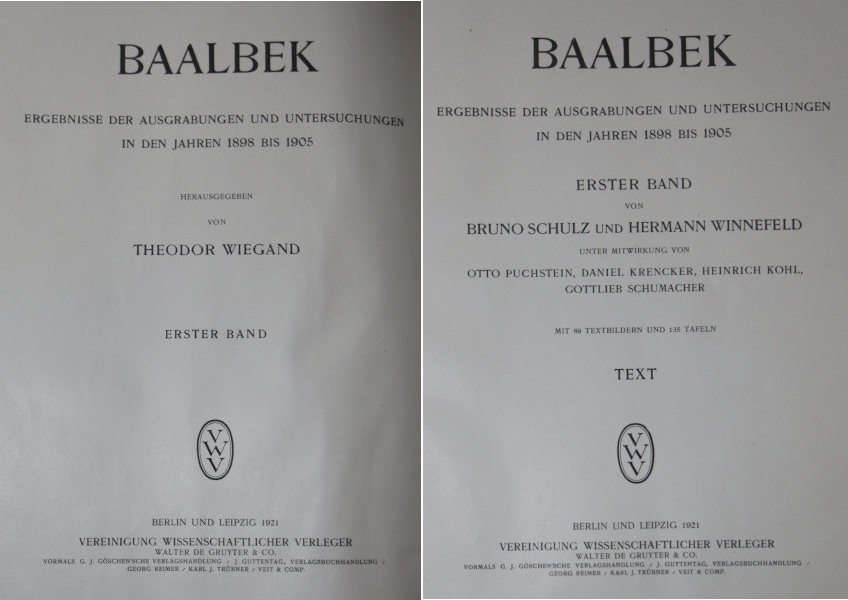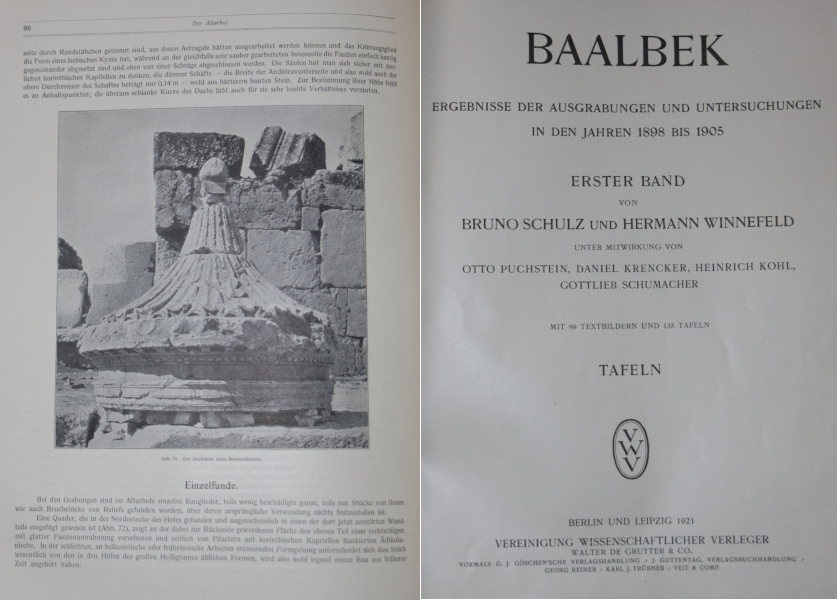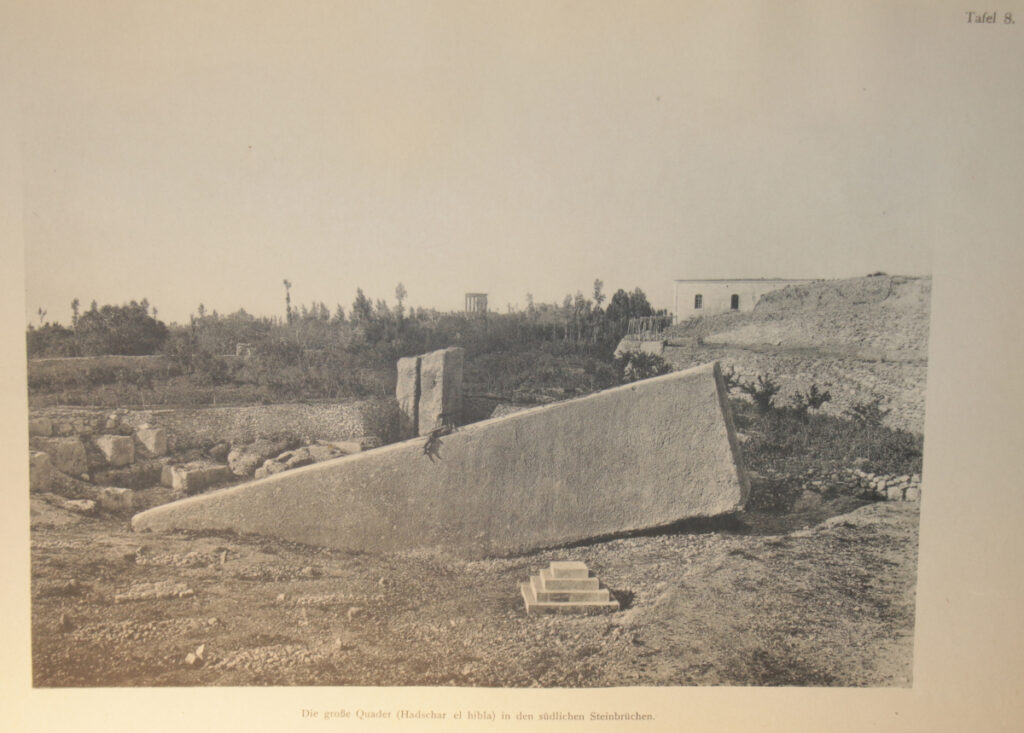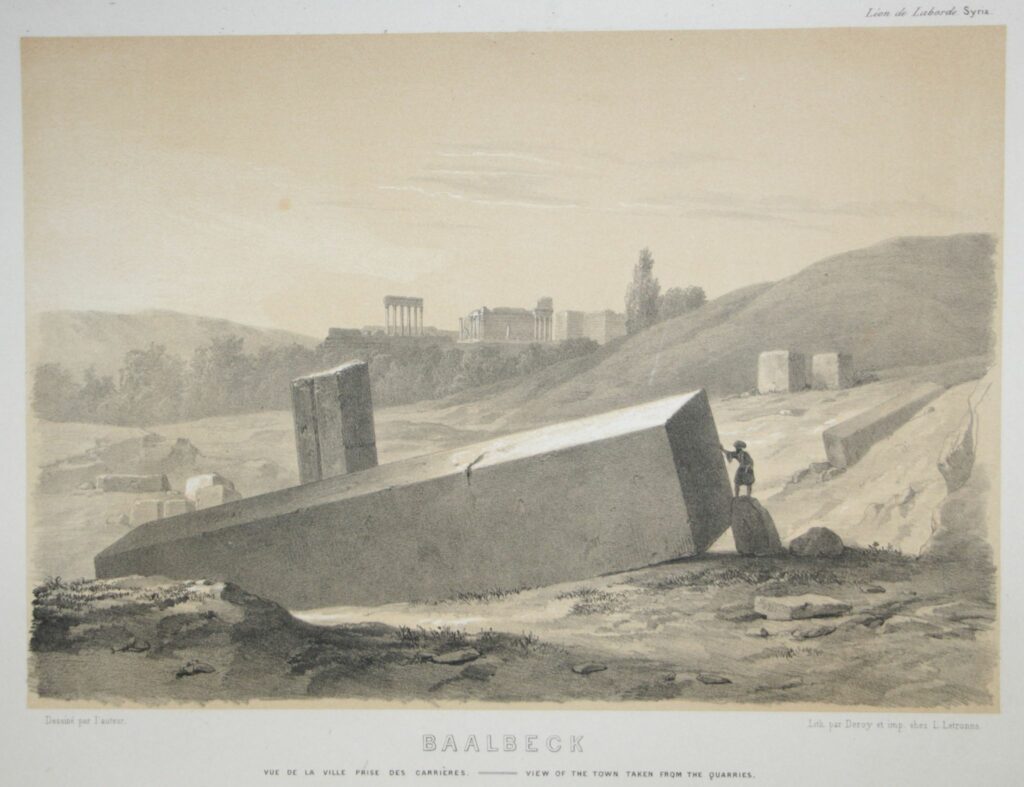Theodor Wiegand: Baalbek; Ergebnisse der Ausgrabungen und Untersuchungen in den Jahren 1898 bis 1905.
Published by Vereinigung wissenschaftlicher Verleger Walter de Gruyter & Co., Berlin.
Exceedingly rare complete first edition of this work.
Vol. I, Erster Band,1921, Text: pp. (8), 130 (letterpress);
Vol. I, Erster Band, 1921, Tafeln: pp. vii, 136 plates, numbered 1 – 44, 44a, 45 – 135. Some of the plates double page.
Vol. II, Zweiter Band, 1923, pp. xiv, 151 (letterpress); followed by 66 plates, numbered 1 – 14, 15/16, 17 – 50, 51/52, 53 – 66, 67/68, 69.
The plates numbered 15/16, 51/52 and 67/68 are double page plates.
Vol. III, Dritter Band, 1925, pp. x, 1, (1), 145 (letterpress); followed by 24 plates of which 2 are chromolithographs. Plate nr. 13 consisting of 2 pages.

Folio, paper size: 352 x 281 mm. All three volumes bound in contemporary green shagreen over marbled paper covered boards. The spines divided in six compartments by five raised bands with the titles in the second and fourth compartment on maroon labels. The other compartments gilt decorated.
The foundational and most important publication on Baalbek is the series produced by the German archaeological mission led by Otto Puchstein and colleagues, initiated after Emperor Wilhelm II’s visit in 1898.
This multi-volume work, completed in the early 20th century, is considered the cornerstone for all subsequent architectural and archaeological research on the site and this publication remains the foundation of all architectural research on Balbek.
These volumes meticulously document the temples, ruins, and architectural features of Baalbek, providing detailed illustrations and analysis. Despite later discoveries and research, this early German publication continues to be cited as the essential reference for the study of Baalbek’s monumental Roman architecture and archaeological history.
Additional Context
- The UNESCO World Heritage Centre also provides official documentation and nomination files, which are authoritative for understanding Baalbek’s universal value and preservation status, but the German archaeological volumes remain the primary scholarly reference.
- More recent scholarly works, such as “Baalbek-Heliopolis, the Bekaa, and Berytus from 100 BCE to 400 CE,” offer updated perspectives and syntheses but build upon the foundation laid by the German mission.
Key Reasons for Importance
1. First Comprehensive Scientific Documentation
- Wiegand’s publications (1921–1925) were among the earliest and most exhaustive scientific studies of the Baalbek ruins, particularly the temples of Jupiter and Bacchus.
- His work provided detailed architectural plans, drawings, and photographic records that set a new standard for archaeological documentation of ancient site.
2. High-Precision Architectural Surveys
- The German archaeological mission led by Wiegand produced highly accurate surveys and reconstructions of the site. These detailed floor plans and measured drawings have been invaluable for subsequent research, restoration, and comparative studies of Roman architecture.
- Wiegand’s documentation remains a reference point for both the morphology and planning phases of the sanctuary.
3. Influence on Understanding Roman and Local Syncretism
- Wiegand’s analysis highlighted how the temples at Baalbek, especially the Temple of Bacchus, blended Roman religious architecture with local traditions and motifs. This insight has influenced later scholarship on cultural and religious syncretism in the Roman East, demonstrating how imperial architecture could incorporate and codify local religious practices and aesthetics.
4. Foundation for Further Research
- The thoroughness of Wiegand’s work has enabled later generations of archaeologists and historians to build upon his findings. His publications are frequently cited in modern studies, and his interpretations continue to inform debates about the function, symbolism, and chronology of the Baalbek complex.
5. Preservation of Knowledge
- Given the challenges of preservation and the risks posed by conflict and environmental factors in Lebanon, Wiegand’s early 20th-century documentation has preserved a wealth of information that might otherwise have been lost.
The results of the early 20th-century German archaeological expedition led by Otto Puchstein, edited and published by Theodor Wiegand is universally recognized as the most important and foundational work on Baalbek. Primarily due to its foundational role in the scholarly understanding and documentation of the monumental Roman temple complex at Baalbek, Lebanon.









A digital facsimile can be found at https://archive.org/details/gri_33125008087831/mode/2up?view=theater
For comparison below two pictures from the same site. Above Tafel 53, Erster Band from Wiegand’s Baalbek and below a lithograph of the same location taken from ‘Voyage de La Syrie’ drawn by Léon de Laborde during the 1830’s.


And another two comparable pictures: Above Tafel 8, Erster Band and below a lithograph taken from ‘Voyage de La Syrie’.

